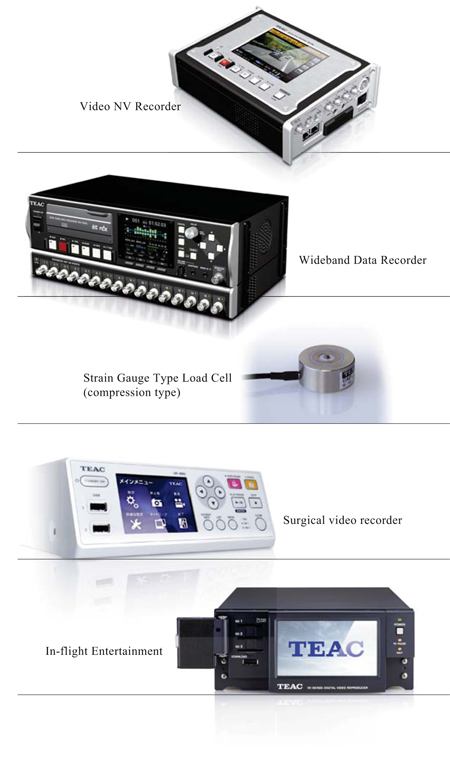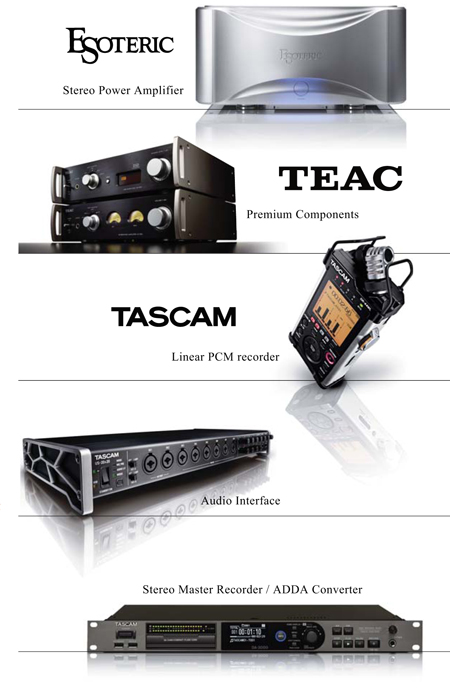Company
About TEAC
TEAC was originally founded as Tokyo Television Acoustic Company in August 1953. Its goal was to be a leader in magnetic recording technology. Over the years, the challenge to be at the cutting edge of data recording technology has pushed the company forward.
The guiding principle of TEAC is to enrich our society through our innovative products. For over 70 years, TEAC has been well known for video, image and sound recording technologies, and now introduces medical imaging recorders.
With the continued growth of Minimally Invasive and Endoscopic Surgery and Hybrid OR, having very reliable and high quality solutions for the recording and playback of medical videos and images that are used to explain, educate, and share has never been more critical.
With this focus on quality and reliability in mind, TEAC continues to develop convenient and easy to use recording solutions that meet and exceed the needs of our customers and partners.

TEAC was originally founded as Tokyo Television Acoustic Company in August 1953. Its goal was to be a leader in magnetic recording technology.
Over the years, the challenge to be at the cutting edge of data recording technology has pushed the company forward.
The guiding principle of TEAC is to enrich our society through our innovative products.
For over 70 years, TEAC has been well known for video, image and sound recording technologies, and now introduces medical imaging recorders.
With the continued growth of Minimally Invasive and Endoscopic Surgery and Hybrid OR, having very reliable and high quality solutions for the recording and playback of medical videos and images that are used to explain, educate, and share has never been more critical.
With this focus on quality and reliability in mind, TEAC continues to develop convenient and easy to use recording solutions that meet and exceed the needs of our customers and partners.
TEAC has pursued the highest level of technology for recording and playback since its foundation in 1953.
It has provided products utilizing the technology cultivated since its foundation to the medical field for approximately 30 years, and the number of medical imaging products provided for this field up until now totals over 60,000.
In the past few years, the technology required for the medical field has significantly changed together with the development and advancement of medical technology.
For example, a gastrointestinal endoscope is used for the purpose of examining inside the gastrointestinal tract, mainly the stomach and large intestine, but the areas of concern in video output to the monitor are ordinarily recorded as still images.
However, as technology has advanced in recent years, a gastrointestinal endoscope not only has a role in examinations but is also used for patient treatment (resection), so the need to record video of the overall procedure in addition to still images has become great.
Furthermore, in the field of surgery, minimally invasive endoscopic surgery has also become widespread.
Unlike abdominal operations in which a large incision is made to open up the abdomen, an opening of about a few centimeters is sufficient with endoscopic surgery so the burden on the patient is greatly reduced.
The number and percentage of stomach, large intestine, and other endoscopic surgeries performed increase yearly, and there has been an expansion in the deployment of the new technologies of HD and 3D for endoscope video to show the site of surgery.
Currently, robots that perform endoscopic surgery are being used in actual medical settings.
The frequency with which cameras, in particular, endoscope cameras, are used in such medical settings has become high, and there is a growing need to record surgical procedures shown by such cameras as video.
A rocket is launched into space beyond the stratosphere.
The success of a rocket launch greatly depends on the rocket engine.
At present, there is a need for rocket engine development which started with the LE-5 not only to increase the reliability of launching a rocket into space, but also to enable reuse of the rocket engines used for the launch and to be conscious of the cost and increase economic efficiency.
TEAC's data recorders for vibration and pressure measurement have been in use for 30 years since the start of rocket engine development for recording rocket engine development measurement data.
Engine vibration data analysis is extremely important for new rocket engine development.
A simulation of actual harsh operating conditions such as extremely low temperature, high pressure, and high-speed spinning, and testing under these conditions enables the study of highly durable engines and the development of highly reliable rocket engines.
Vibration exceeding the prescribed threshold reduces the engine's energy efficiency and adversely affects other components.
Test data analysis is essential to eliminate such problems.
TEAC's recording technology to ensure more reliable recording of measurement data of tests is used to certify the health of engines.
Unlike other data recorders, TEAC's data recorders enable multi-channel high-speed data recording.
Accordingly, a large volume of data can be recorded at multiple locations (on up to 128 channels) for a single test.
For field applications where a lot of time and money are spent on a single test, there is a need to ensure the recording of data with a wide bandwidth even on many channels.
TEAC's recording technology is used in various locations besides the medical field.
The 1964 Tokyo Olympics was the first Olympics held in Asia.
This Olympics was also called a "TV Olympics" due to utilization of the latest video technologies at that time, including broadcast to foreign countries via satellite, color broadcast, and live coverage of the entire marathon course, which promoted explosive TV penetration.
Do you know that TEAC greatly contributed to the video technologies used in this Tokyo Olympics?
What TEAC contributed is the world's first slow-motion VTR. Upon request from the NHK Science & Technology Research Laboratories at that time, TEAC greatly supported NHK in the development.
Mr. Iwasawa, a retired TEAC engineer, who led the development project at that time, tells the story as follows.
Upon strong request from the Headquarters at the Olympic Broadcasting Services for the development of a slow-motion VTR in July 1962, two sections of the NHK STRL (the Recording Technology Special Research Laboratories and the Development Department) started competing in the development of a new recording method.
The Recording Technology Special Research Laboratories, of which I was a member at that time, studied the possibility and feasibility of a recording mechanism and put together a prototype proposal with support from TEAC. It was the result of a half year's cooperation.
We hoped very much that if we made something good, it would be used for not just any broadcast but in particular for Olympic broadcast.
TEAC's President, Mr. Tani, said, "How can I say no when it comes to the national flag?" and the custom equipment group of TEAC immediately came to support us.
Mr. Iwasawa talks about the difficulty in the development.
We had difficulty in stabilizing the operation of the prototype recorder. Since the recorder used both transistors and vacuum tubes, we struggled with solving various problems, such as heat generation, power supply voltage fluctuations, temperature and humidity, dust, mechanical vibration, misoperation, and so on.
It was also difficult to establish a servo system technology to spin the motor stably. Our technology enabled spinning a motor with a precision of 0.1 microsecond fluctuation at the passage time of the magnetic head running at the speed of the Shinkansen (the bullet train).
Mr. Iwasawa talks about an event by which he was especially impressed.
When broadcasting the 1963 Tokyo International Sports Week (Pre-Olympics), a Japanese athlete won the women's hurdles race.
The scene was recorded with the slow-motion VTR being used on a trial basis and the slow-motion video was sent to the on-air control room.
A program director who watched it shouted, "It's amazing! Broadcast it right away." The order was given by phone and it was broadcast immediately.
It was a very impressive event. Mr. Iwasawa felt strongly that many people are looking forward to watching slow-motion videos that have captured the dynamic moments of athletes.
Inheritance of Technology
This slow-motion VTR technology has continued to evolve and is now widely used in various visual fields besides sporting events.
TEAC uses this inherited technology, for example, for video recorders that record medical images, data recorders that record vibration, pressure, electrical, image, and other signals, and video players for in-flight entertainment, thus continuing to contribute to the industrial field.
A record of human endeavors
| Human culture can trace its heritage back to three things: fire, tools and language. Spoken words were first recorded as handwritten words, followed by the introduction of the printing- press, allowing documents to be widely accessible to the general public. Human memory, on the other hand, deteriorates overtime, making it unreliable for precise intellectual activities. To compensate for this, accurate recording, storing and playback technology is indispensable for human progress. Therefore, advances in recording technology have been an integral element in the expansion of human thought and analysis. We all bear witness to the emergence of new ideas brought about by the ever increasing advancement of information and recording technologies. From paper to electrons, the format of information and data storage is constantly changing. As larger and larger databases are integrated into information systems, digital data storage will continue to play a key role in the establishment of new directions of creativity. |
Human culture can trace its heritage back to three things: fire, tools and language. Spoken words were first recorded as handwritten words, followed by the introduction of the printing- press, allowing documents to be widely accessible to the general public. Human memory, on the other hand, deteriorates overtime, making it unreliable for precise intellectual activities.
To compensate for this, accurate recording, storing and playback technology is indispensable for human progress.
Therefore, advances in recording technology have been an integral element in the expansion of human thought and analysis.
We all bear witness to the emergence of new ideas brought about by the ever increasing advancement of information and recording technologies.
From paper to electrons, the format of information and data storage is constantly changing.
As larger and larger databases are integrated into information systems, digital data storage will continue to play a key role in the establishment of new directions of creativity.
Click here to learn more about TEAC corporation.
INFORMATION PRODUCTS
| Combining high-precision recording and communication technology that leaps ahead in its field for information devices |
|---|
| By integrating recording technologies for all types of information, including sound, images, data, etc. with the remarkable advances being made in communication technologies, TEAC is steadfastly meeting the challenges of developing high quality technology, products and services that customers demand. TEAC is poised to make a major leap forward in the field of information technology. |
| Measurement Devices |
|---|
| Technology to Measure, Collect, and Integrate data for analysis |
| By developing and producing measurement and analysis devices, marketing and providing support, TEAC will contribute to R&D, basic technology development, and labor-saving at manufacturing sites in the industrial, disaster prevention, environmental, and basic medical sectors. After a measurement device measures and collects data, that data is recorded and integrated during the analysis and processing stages. The data thus compiled will yield valuable information for customers. |
| Video and Image Recording Devices |
| Integration of Video and Image Recording Technologies with Vibration and Impact Resistant Technologies |
| TEAC is highly regarded around the world for its image and video recording technologies employed in special VTRs that can be used under harsh environments such as those encountered in space exploration. We also offer disc recorders for large-volume medical images for ultrasonic, microscopic, funduscopic examinations. Using basic technology for high-precision mechanics and image compression, we are developing new video and image recording devices for these image monitoring markets. |
| In-flight Entertainment Products |
| In-flight entertainment in the skies worldwide |
| TEAC has developed in-flight entertainment video players based on years of research into VTR technology. The device is designed for use under harsh conditions, so it features durable, compact and light weight design, as well as low power consumption. Perfectly fulfilling all of the requirements for passenger planes. |

AUDIO AND VIDEO EQUIPMENT
| From analog to digital recording and playback, the driving force behind the development of global audio products has been a quest for the most advanced technology |
|---|
| TEAC started developing audio products from the very first days of its history. The first audio product produced was designed by TEAC founder Katsuma Tani and shipped in 1939. More than half a century later, substantial expertise in magnetic recording technology has culminated in the development of a range of outstanding audio products. That early knowledge helped to set the stage for Japan' s emergence as a major player in the electronics industry. The drive to enhance audio and video technology for years to come continues to motivate us to confront new challenges. |
| High-end Audio |
|---|
| Products for genuine music lovers, with TEAC's pride and conviction as standard |
| Great audio comes from a passion for music. Music has the power to recreate the deepest emotions; TEAC' s high end brand, ESOTERIC has caused a sensation in the Japanese High-end audio world by continuously creating products that can capture the essence of the moment with the most state of the art technology. ESOTERIC is leading the world with its mastery of sound. |
| Home Audio products |
| Design and functionality that surpasses tradition Enjoy audio and discover new music on multiple devices with optimal compatibility |
| Everyone can know the joy of listening to music. TEAC creates home audio products with the technology and creative thinking to allow you to incorporate music into your everyday life. Not just design, but functionality and usability have to be considered for a great product. From the newest digital media to the most reliable analog record player, anyone can experience a variety of media from past to modern day with these great products. |
| Pro & Broadcast Industry Audio products |
| The design of recording and playback equipment that began with Japan's first television broadcast, enters a new era with heightened sensitivity |
| Music is the product of a refined sensibility. In this domain, TEAC has consistently maintained the principle of faithfully reproducing the real essence of sound in recording and playback. During the postwar reconstruction period, TEAC was acclaimed for the design of its recording and playback systems used by Japan Broadcasting Corporation (NHK). TASCAM products and recording and playback systems have reformed the world of creative sound. |

History of TEAC brand
| 2022 | UR-NEXT 4K 4K UHD Medical Video Recorder Release |
|---|---|
| 2020 | UR-X / UR-Xi FULL HD Surgical Video Recorder Release |
| 2019 | MV-1 FHD still and Video image recorder Release |
| 2018 | SURGE ONE v2 A medical/surgical contents management system Release |
| 2017 | MV-7000S Still and Video image recorder (internal HDD,SD cards) Release MV-7000H HD still and Video image recorder (internal HDD,SD cards) Release |
| 2016 | S'CORE Embedded DVR board Release |
| 2015 | SURGE ONE A medical/surgical contents management system |
| 2014 | UR-4MD high-definition medical imaging recorder Release MV-3CH-D HD Still and Video image DICOM GATEWAY |
| 2013 | MV-3CH HD still and Video image recorder (internal HDD, SD cards) Release MV-3CS-D Still and Video image DICOM GATEWAY |
| 2012 | MV-3CS still and Video image recorder (internal HDD, SD cards) Release |
| 2011 | UR-50BD high-definition medical video recorder Release |
| 2009 | MV-10XH HD still image recorder (internal HDD, SD cards) Release |
| 2005 | MV-H10 HD still image recorder (DVD-RAM) Release |
| 2002 | DV-700 MPEG-2 video recorder (DVD-RAM) Release |
| 1998 | European model MV-300P PAL still image recorder Release |
| 1997 | DV-500 Motion-JPEG video recorder (3.5 inch MO) Release |
| 1992 | SV-100M JPEG still image recorder (3.5 inch MO) Release As recorder instead of monochrome video printer |

